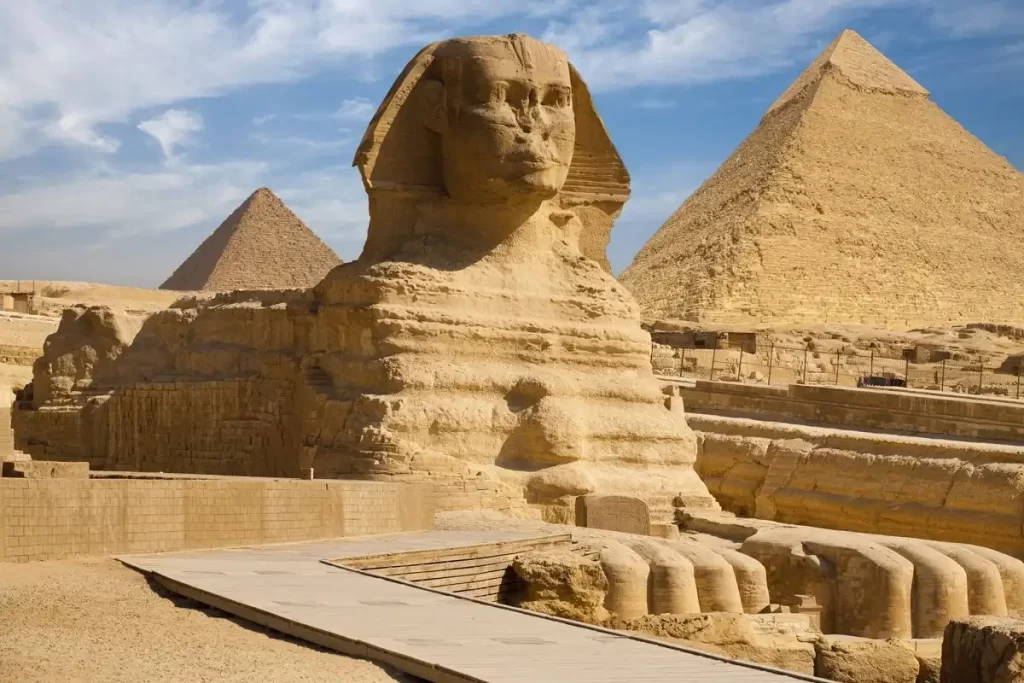
The Great Sphinx
[ez-toc]
Overview of The Great Sphinx
The Great Sphinx is regarded as the personification of antiquity and mysticism. The main objective of this article is to provide every traveler with all available facts and information on the enormous Sphinx. A group of tour operators, tour guides, informed historians, and travel advisors who are experts on the great sphinx wrote this page. Over the centuries and even today, despite the fact that its genesis is still a mystery, it has sparked the imagination of numerous poets, travelers, explorers, and scientists. This amazing figure, which displayed an entirely new facet of ancient Egyptian mythology, architecture, and creative expression, has inspired many stories of mystery and amazement.
Facts
The Sphinx, which lies on the Giza plateau in front of the Khafre (Chephren) pyramid and faces the horizon as the sun rises, is one of the largest and oldest sculptures ever made. It is situated about 10 kilometers west of the Egyptian capital Cairo. The Sphinx is the embodiment of royal authority and the guardian of the temple entrances. It stands in for Ra-Horakhty, a mighty sun deity. It is carved into the form of the fabled monster known as the Sphinx, which has the body of a lion and the head of a human, as well as a regal headpiece to signify wisdom and power. It is composed of a single block of limestone. It stands at has a Length of 73 meters (240 ft), a Width of 19 meters (62 ft), and a height of 20 meters (66 ft).
The sphinx was thought to be a feature of the necropolis in ancient Memphis and the pharaohs’ administrative center. It is situated close to the three Great Pyramids of Giza: the Pyramid of Menkaura, the Pyramid of Khafre, and the Great Pyramid of Khufu (Cheops) (Mycerinus). Between its foot paws, it is holding a tiny temple with twelve steles honoring the sun deity Ra that is inscribed.
The pharaoh Tuthmosis IV placed a little tablet between its feet and paws about 1400 BC called the dream tablet, which has a dozen steles engraved in praise of the sun god Ra. It is well known that the statue was erected during the 4th dynasty of ancient Egypt, during the reign of Pharaoh Khafre (2558–2532 BC), who also built the second pyramid. However, the exact year of the statue’s construction is still unknown. The existence of the Sphinx on the Giza Plateau and in the complex of the Karnak temples can be explained by the fact that during the old kingdom in the fourth dynasty, the sphinx statues were thought to be the ultimate guards of the cemetery.
Some of the most famous queens and princesses of the New Kingdom during the 12th dynasty were portrayed in the shape of the Sphinx, including the sphinx statue of Queen Nefertiti, which is located in the eastern part of the Karnak complex and has a hair wig in place of Nemes, and the sphinx statue of Queen Hatshepsut, which is located at her mortuary temple. Many of the kings and queens of the Greco-Roman era brought numerous Egyptian Sphinxes to Europe, where they are still found today.
The Mysterious Nose of the Great Sphinx
There are still many mysteries surrounding the statue, such as the origin of his famous nose. According to various theories, it was destroyed by Napoleon’s troops between 1798 and 1801 CE, but this is incorrect because a famous drawing of the nose’s devastation from 1737 by French artist Frederic Luis Norden proves otherwise. There is no definitive answer, but the most likely scenario is that the nose was harmed during the Arab invasion of the 7th century, by a Muslim priest in the 14th century, as a target practice by Turkish troops in 1798 CE, by the Mamluks, or by British troops. The Sphinx also contains a beard that was attached to it at a later period which is located at the British Museum. The statue was painted with red pigment with some yellow and blue like a character in a comic book.
The Dream Stela of the Sphinx
A granite stela known as the dream stela was erected between the front paws of the sphinx during the reign of Pharaoh Tuthmosis IV in 1400 BC. This was done as a result of the pharaoh’s dream in which the great sphinx came to life while the pharaoh was choking in the sand and promised Tuthmosis IV that if he removed the sand engulfed.
The Sphinx Age
The age of the Sphinx, which is said to have been built around 2500 BC in the likeness of pharaoh Khafre, has long been a topic of discussion. This helps to explain why the Sphinx is precisely positioned geographically next to the Khafre Pyramid. According to Robert Bauval and Graham Hancock’s hypothesis of the alignment of the Orion constellation and its relative location to the Milky Way, the sphinx has a lion’s body and a human head, which some have said to be a tribute to the constellation of Leo. They held that the great sphinx’s construction started in 10,500 BC and that the design of the lion on the sphinx is a reference to the constellation Leo. They also believed that the layout of the Giza pyramid complex and the Nile River is an exact reflection and map of the Milky Way, Orion belt, and constellation Leo from 10,500 BC.
According to the observation, these celestial bodies were present during the Leo astrological age, which lasted from 10,970 to 8810 BC, indicating that they are significantly older than previously thought. According to others, the head was repaired by being recarved several times after the end of the old monarchy (2575 BC–2150 BC), changing the facial proportions from the original form, which could have been the head of a ram or a hawk.
Evoulation of the Sphinx
The Sphinx was present during the dynasty era in a straightforward two-dimensional form, although it later underwent changes. The sphinx statues from the Old Kingdom had a human head on a lion’s body, a fake royal beard, and the name’s headpiece. In the Middle Kingdom, the sphinx simply served as a symbol for the ruler, with a human head and lion mane surrounding it. During the middle kingdom in the second half of the 12th dynasty, Amenemhat III was the first monarch to ever represent himself as a sphinx with a lion’s mane. The sphinx statues of the New Kingdom maintain the characteristics of the Middle Kingdom, although they made significant adjustments like changing the forelegs of the waning lion into human arms carrying cult artifacts. King Amenhotep III was the first king to depict himself in this shape.
Erosion Effects on the Sphinx
The water erosion theory, which asserts that signs of weathering were noticed due to heavy rainfall over the sphinx at the end of the ice age between 7,000 BC and 5,000 BC, is another theory that discusses the age of the Sphinx. This theory suggests that the sphinx was built when Egypt was a dry and desolate land. Before being impacted by natural factors, the sand that formerly covered the sphinx served as a protective field.
Secrets Tunnels under the Great Sphinx
Researchers from Waseda University in Japan, Florida State University, and Boston University discovered a number of voids and anomalies near the monument. Two networks of tunnels, caverns, and paths that run parallel to the large sphinx could be local natural features. Researchers were able to validate the myths about secret chambers and tunnels between the sphinxes when they used a seismograph to detect evidence of a hollow 25 feet below the sphinx’s paws and flanks.
Names of the Great Sphinx
It was known by many names throughout history, including Hor-em-Akhet (Horus of the Horizon) in the New Kingdom of Egypt (1570–1050 BC), the Sphinx during the Greco–Roman period because of its resemblance to the Greek mythological creature with a lion’s body, a woman’s head, and eagle wings known as the Sphinx, and Bel-Hit in the Fourth Century of the Coptic Era, which means the Sphinx is a Greek term for the living image, or “SSP” Ankh, which is an ancient Egyptian moniker. The sphinx’s design is a timeless and magnificent fusion of physical and mental strength, with the physical strength taking the form of a lion’s body and the cerebral strength taking the form of a human head. The Sphinx stands for the ability of the mind and human intelligence to subdue the lion’s aggression and strength.
Theories about the Sphinx
The Great Sphinx has been the subject of numerous theories throughout the years, and there has been intense discussion about who, why, and when it was constructed. There are no records of any kind in the old kingdom that would provide any information about the statue’s age or construction, and the statue had been damaged and restored numerous times over the millennia. This caused many archaeologists and Egyptologists to debate its origin and even lead them to outlandish and even fringe theories.
Everything about the sphinx is up for controversy, including who built it. Some have suggested that the Annunaki—a set of deities that appeared in the prehistoric civilizations of Sumeria, Akkadian, Assyria, and Babylon—were responsible for building the sphinx. Some individuals with active imaginations believe that the placement of the Sphinx and the Pyramids is a copy or a reflection of pyramid-shaped buildings discovered on Mars or perhaps Giza as some sort of spacecraft landing strip.



